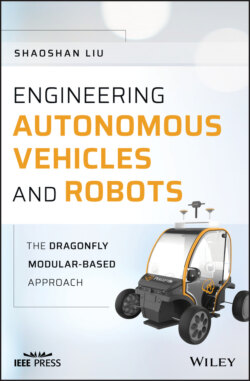Читать книгу Engineering Autonomous Vehicles and Robots - Shaoshan Liu - Страница 27
1.6 Open Source Projects Used in this Book
ОглавлениеAs you can see, an autonomous driving system is a highly complex system that integrates many technology pieces and modules. Hence, it is infeasible and inefficient to build everything from scratch. Hence, we have referred to many open source projects throughout the book to help readers to build their own autonomous driving systems. Also, throughout the book we have used PerceptIn's autonomous driving software stack to demonstrate the idea of modular design. The open source projects used in this book are listed below:
CANopenNode [14]: This is free and open source CANopen Stack is for CAN bus communication.
Open Source Car Control [15]: This is an assemblage of software and hardware designs that enable computer control of modern cars in order to facilitate the development of autonomous vehicle technology. It is a modular and stable way of using software to interface with a vehicle's communications network and control systems.
OpenCaret [16]: This is an open source Level-3 Highway autopilot system for Kia Soul EV.
NtripCaster [17]: A GNSS NTRIP (Networked Transport of RTCM via Internet Protocol) Caster takes GNSS data from one or more data stream sources (Base Stations referred to as NTRIP Servers) and provides these data to one or more end users (often called rovers), the NTRIP Clients. If you need to send data to more than one client at a time, or have more than one data stream, you will need a Caster.
GPSD (GPS Daemon) [18]: This is a service daemon that monitors one or more GNSS receivers attached to a host computer through serial or USB ports, making all data on the location/course/velocity of the sensors available to be queried on Transmission Control Protocol port 2947 of the host computer. With GPSD, multiple location-aware client applications can share access to supported sensors without contention or loss of data. Also, GPSD responds to queries with a format that is substantially easier to parse than the NMEA 0183 emitted by most GNSS receivers.
Kalibr [19]: This is a toolbox that solves the following calibration problems:– Multiple camera calibration: intrinsic and extrinsic calibration of a camera system with non-globally shared overlapping fields of view.– Visual-inertial calibration (camera-IMU): spatial and temporal calibration of an IMU with respect to a camera system.– Rolling shutter camera calibration: full intrinsic calibration (projection, distortion, and shutter parameters) of rolling shutter cameras.
OpenCV [20]: OpenCV (Open Source Computer Vision Library) is an open source computer vision and machine learning software library. OpenCV was built to provide a common infrastructure for computer vision applications and to accelerate the use of machine perception in the commercial products.
ORB-SLAM2 [21]: This is a real-time SLAM library for Monocular, Stereo and RGB-D cameras that computes the camera trajectory and a sparse 3D reconstruction. It is able to detect loops and relocalize the camera in real time.
libELAS [22]: This is a cross-platform C++ library with MATLAB wrappers for computing disparity maps of large images. Input is a rectified grayscale stereo image pair of the same size. Output is the corresponding disparity maps.
Mask R-CNN [23]: This is a deep learning model for object detection and instance segmentation on Keras and TensorFlow.
Baidu Apollo [24]: Apollo is a high performance, flexible architecture which accelerates the development, testing, and deployment of autonomous vehicles.
OpenStreetMap [25]: This is a collaborative project to create a free editable map of the world. The geodata underlying the map are considered the primary output of the project. The creation and growth of OpenStreetMap has been motivated by restrictions on use or availability of map data across much of the world, and the advent of inexpensive portable satellite navigation devices.
